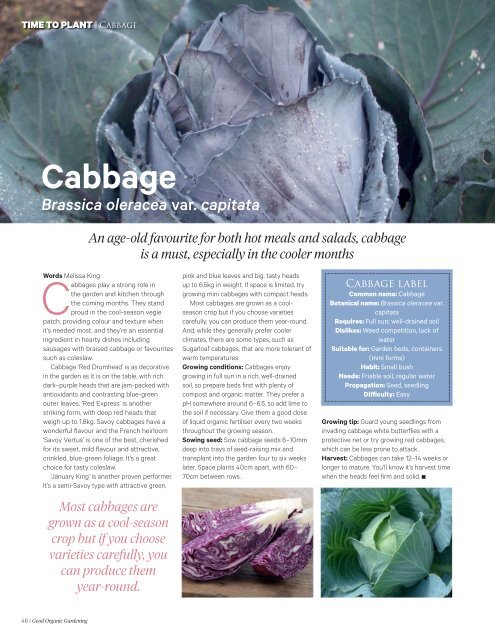3. Good Organic Gardening - May-June 2016 AvxHome.in
3. Good Organic Gardening - May-June 2016 AvxHome.in
3. Good Organic Gardening - May-June 2016 AvxHome.in
Create successful ePaper yourself
Turn your PDF publications into a flip-book with our unique Google optimized e-Paper software.
TIME TO PLANT | Cabbage<br />
Cabbage<br />
Brassica oleracea var. capitata<br />
An age-old favourite for both hot meals and salads, cabbage<br />
is a must, especially <strong>in</strong> the cooler months<br />
Words Melissa K<strong>in</strong>g<br />
Cabbages play a strong role <strong>in</strong><br />
the garden and kitchen through<br />
the com<strong>in</strong>g months. They stand<br />
proud <strong>in</strong> the cool-season vegie<br />
patch, provid<strong>in</strong>g colour and texture when<br />
it’s needed most, and they’re an essential<br />
<strong>in</strong>gredient <strong>in</strong> hearty dishes <strong>in</strong>clud<strong>in</strong>g<br />
sausages with braised cabbage or favourites<br />
such as coleslaw.<br />
Cabbage ‘Red Drumhead’ is as decorative<br />
<strong>in</strong> the garden as it is on the table, with rich<br />
dark–purple heads that are jam-packed with<br />
antioxidants and contrast<strong>in</strong>g blue-green<br />
outer leaves. ‘Red Express’ is another<br />
strik<strong>in</strong>g form, with deep red heads that<br />
weigh up to 1.8kg. Savoy cabbages have a<br />
wonderful flavour and the French heirloom<br />
‘Savoy Vertus’ is one of the best, cherished<br />
for its sweet, mild flavour and attractive,<br />
cr<strong>in</strong>kled, blue-green foliage. It’s a great<br />
choice for tasty coleslaw.<br />
‘January K<strong>in</strong>g’ is another proven performer.<br />
It’s a semi-Savoy type with attractive green,<br />
Most cabbages are<br />
grown as a cool-season<br />
crop but if you choose<br />
varieties carefully, you<br />
can produce them<br />
year-round.<br />
p<strong>in</strong>k and blue leaves and big, tasty heads<br />
up to 6.5kg <strong>in</strong> weight. If space is limited, try<br />
grow<strong>in</strong>g m<strong>in</strong>i cabbages with compact heads.<br />
Most cabbages are grown as a coolseason<br />
crop but if you choose varieties<br />
carefully, you can produce them year-round.<br />
And, while they generally prefer cooler<br />
climates, there are some types, such as<br />
Sugarloaf cabbages, that are more tolerant of<br />
warm temperatures.<br />
Grow<strong>in</strong>g conditions: Cabbages enjoy<br />
grow<strong>in</strong>g <strong>in</strong> full sun <strong>in</strong> a rich, well-dra<strong>in</strong>ed<br />
soil, so prepare beds first with plenty of<br />
compost and organic matter. They prefer a<br />
pH somewhere around 6–6.5, so add lime to<br />
the soil if necessary. Give them a good dose<br />
of liquid organic fertiliser every two weeks<br />
throughout the grow<strong>in</strong>g season.<br />
Sow<strong>in</strong>g seed: Sow cabbage seeds 6–10mm<br />
deep <strong>in</strong>to trays of seed-rais<strong>in</strong>g mix and<br />
transplant <strong>in</strong>to the garden four to six weeks<br />
later. Space plants 40cm apart, with 60–<br />
70cm between rows.<br />
Cabbage label<br />
Common name: Cabbage<br />
Botanical name: Brassica oleracea var.<br />
capitata<br />
Requires: Full sun; well-dra<strong>in</strong>ed soil<br />
Dislikes: Weed competition, lack of<br />
water<br />
Suitable for: Garden beds, conta<strong>in</strong>ers<br />
(m<strong>in</strong>i forms)<br />
Habit: Small bush<br />
Needs: Friable soil, regular water<br />
Propagation: Seed, seedl<strong>in</strong>g<br />
Difficulty: Easy<br />
Grow<strong>in</strong>g tip: Guard young seedl<strong>in</strong>gs from<br />
<strong>in</strong>vad<strong>in</strong>g cabbage white butterflies with a<br />
protective net or try grow<strong>in</strong>g red cabbages,<br />
which can be less prone to attack.<br />
Harvest: Cabbages can take 12–14 weeks or<br />
longer to mature. You’ll know it’s harvest time<br />
when the heads feel firm and solid.<br />
46 | <strong>Good</strong> <strong>Organic</strong> <strong>Garden<strong>in</strong>g</strong>
















